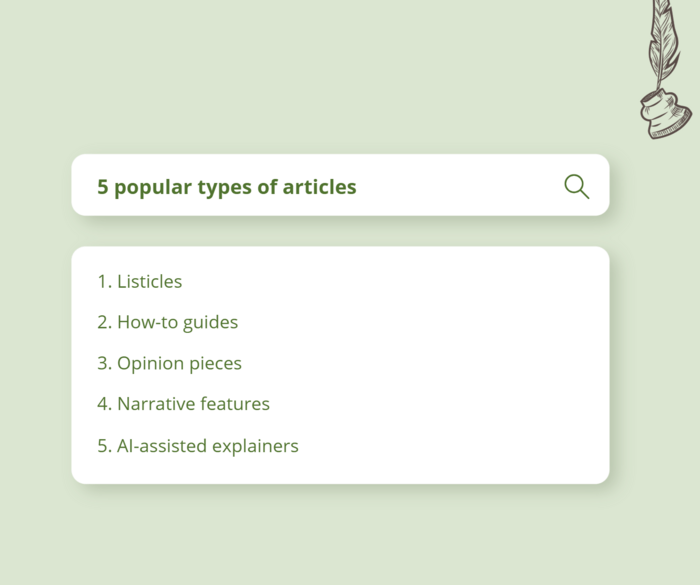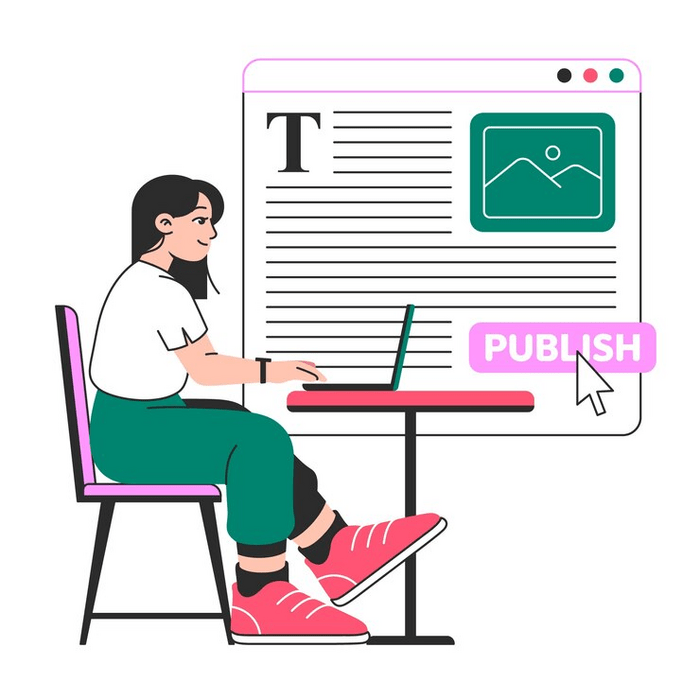8 Steps to Write an Article: Best Practices with Pro Tips to Shine

Writing a great article is like baking a perfect loaf of bread. Start with solid ingredients, add a pinch of creativity, and watch it rise. But before we dive into the how-to, let’s set the stage with what an article is and what types are making waves in 2025.
With this foundation, you’ll be ready to craft pieces that inform, delight, and stand out. Whether you’re new to writing or looking to level up, these eight steps will guide you from blank page to brilliant finish, optimized for readers and the web alike.
Let’s get started!
What is an article?
An article is a written piece that informs, persuades, or entertains, usually published online, in magazines, or on platforms like blogs and newsletters. It’s a chance to share knowledge, spark a conversation, or tell a story. Think of it as a friendly chat with your reader, backed by facts or flair. In 2025, articles are evolving fast, shaped by tech, culture, and how we consume content. While the classics still hold, new flavors are popping up everywhere.
Here are the article types dominating the scene this year:
- Listicles: Quick, scannable lists (like this one!) that deliver value fast. Think “5 Apps to Boost Your Day.”
- How-to guides: Step-by-step advice, from “How to Start a Podcast” to “How to Grow Herbs Indoors,” loved for their practicality.
- Opinion pieces: Bold takes on hot topics, often fueled by X debates. Say, “Why Remote Work Is Here to Stay.”
- Narrative features: Stories that pull you in, like “I Quit My Job to Travel, Here’s What Happened,” blending personal vibes with lessons.
- AI-assisted explainers: Short, smart dives into complex stuff, like “What’s Quantum Computing, Really?” often co-crafted with tools like me, Grok.
In 2025, readers crave bite-sized insights, authenticity, and a touch of tech-savvy sparkle. Keep that in mind as we roll into the steps.
Choose your article topic and audience
Kick off by picking a topic and figuring out why it matters. A clear purpose keeps your writing focused, like a compass guiding you home. Maybe you want to help small business owners boost their social media game or share a passion like urban gardening.
Equally important is knowing who you’re writing for, your target audience. Are they busy parents needing quick tips, tech-savvy teens craving trends, or professionals seeking insights? Nail this down early so your article resonates.
Audience Tips:
- Ask: Who needs this most? Check X or forums for their pain points, like “I’m drowning in emails!”
- Picture them: Age, interests, habits. A 30-something freelancer differs from a retired hobbyist.
Pro tip
Gather smart research
Good research fuels good writing. Dive into books, articles, or expert interviews to collect the facts and insights your article needs. Writing about healthy eating? Grab stats from a nutrition journal, a dietitian’s quote, or even a trending social media post like “Just lost 10 lbs with this one meal tweak!” The goal is to build trust and depth so your readers walk away smarter.
Look for credible sources that offer up-to-date and trustworthy information. Google Scholar and PubMed are great for academic research, while industry blogs, news sites, and government reports provide expert-backed insights.
Tools like Awario can help quickly spot trending discussions on social media, while Reddit and Quora reveal real-world questions people are asking. For quick stats, try Statista or official reports from organizations like the WHO or Pew Research. The key is to balance speed with accuracy—fact-check sources and prioritize reputable ones to keep your content solid.
Pro tip
Build a clear article outline
Before you write, sketch a simple outline to map your journey. Start with an introduction to hook your audience, flow into main points that deliver value, and end with a conclusion that ties it up.
For example, if you’re writing a productivity piece, plan an intro about daily chaos, a section on tools, and a wrap-up with results.
A great structure balances flow and purpose. It feels like a story, grabbing attention, building momentum, and landing smoothly.
Here’s a go-to layout for almost any article type:
- Introduction: Set the scene. Why this matters, maybe with a question or a quick anecdote.
- Body: Break your topic into 2-5 key points, each with examples or insights.
- Conclusion: Sum it up and leave a takeaway, something to think about or try.
To take your outline to the next level, think about pacing and reader engagement. Each section should flow naturally into the next, guiding the reader without overwhelming them. Use subheadings to break up chunks of text, making it easier to scan. Bullet points, numbered lists, and short paragraphs keep things digestible.
Also, consider the reader’s journey—what questions might they have as they move through the piece? Address doubts, anticipate objections, and provide clear, actionable insights. If possible, add a mini call-to-action at the end, like a challenge or a resource suggestion, to keep them engaged beyond the article.
Pro tip
Draft your article with passion
Now it’s time to let the words flow. Don’t stress about perfection, just get your thoughts down. Write like you’re chatting with a friend, sharing what you’ve learned or felt. If your topic’s personal, like overcoming writer’s block, lean into that. “I stared at a blank screen for hours until this one idea clicked.” That raw energy makes a draft worth reading.
Stuck? Ask an AI (ChatGPT, Gemini, Grok, etc.) for a nudge, a catchy opener, or a fresh angle. It might suggest, “Writing is like unknotting earbuds, messy but doable.” Keep it yours, though. Your voice is the star.
Edit the copy for smooth reading
Editing turns a rough draft into a polished gem. Read through to fix typos, clarify fuzzy ideas, and smooth out awkward spots. Maybe “It’s super critical to do this” becomes “It’s essential to get this right.” Take your time. Great writing shines through careful revision, not quick fixes.
Two-Pass Trick:
- First, cut anything that drags, off-topic bits, or slow sentences.
- Second, sharpen your words. Swap vague phrases for vivid ones.
Infuse your unique voice
Your voice sets your article apart, so let it shine. Adjust your tone to fit your audience, warm and relatable for parents, crisp and professional for business folks. Writing about travel? Don’t just list tips. Paint a picture. “I once got lost in Rome and found the best gelato of my life.” That sticks. If a grammar rule, like never starting with “But,” feels stiff, bend it for rhythm. Bonus: Add a photo of that gelato with an alt text like “best gelato in Rome 2025” for extra pop.
Pro tip
Polish and share widely
Your article’s almost ready, but it needs a final touch. After editing, do one last proofreading pass. Catch typos, stray commas, or clunky phrasing. Then share it where your readers hang out. Pick a platform that fits, Medium for stories, your blog for SEO control. A clean title like “gardening hacks for city dwellers” helps it find its crowd. Give it a push to spark interest.
Pro tip
Boost with web optimization
A great article deserves to be seen, and in 2025, that means smart SEO, search engine optimization. Google loves content that’s clear, relevant, and easy to find, so tweak your piece to rank higher. Say you’re targeting “article writing tips.” Use Google to confirm it’s searchable, then weave it into your title, headings, and text naturally. Keep it reader-friendly. Google rewards what people stick around for.
Here are some SEO basics to nail:
- Keywords: Research terms your audience searches (tools like Rank Tracker or Google Search Console can help) and weave them in.
- Headings: Use clear subheads (like these!) to break up content. Google scans them for clues.
- Links: Add a few relevant internal links (to other blog posts) or external ones (to trusted sites) for credibility.
Pro tip
Wrap it up strong
You’ve got everything to write an article that shines: purpose, structure, heart, and a web-savvy edge. These eight steps blend classic wisdom with modern tricks to help you create something readers can’t ignore, whether it’s a how-to, a story, or a bold opinion.
It’s not just about filling a page. It’s about connecting, informing, and climbing those Google ranks. Track views or rankings with Google Analytics to see your shine grow. So grab your topic, fire up your keyboard, and start crafting. Your next great article is waiting.






